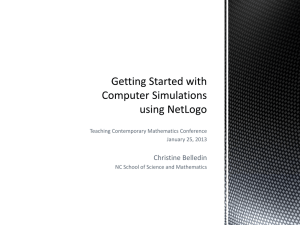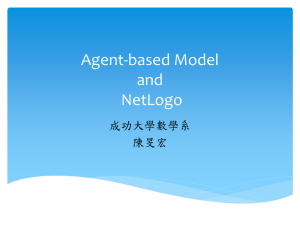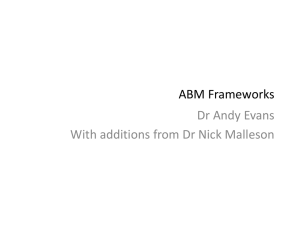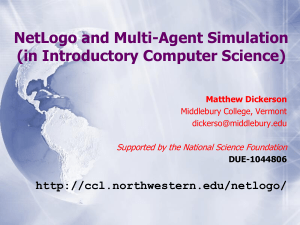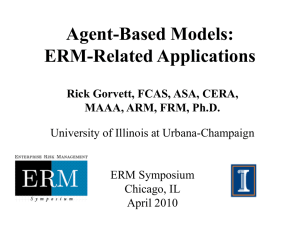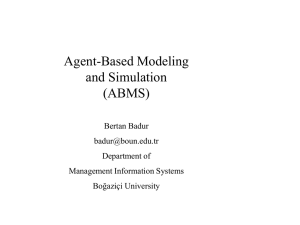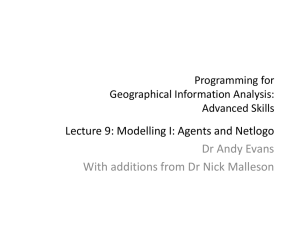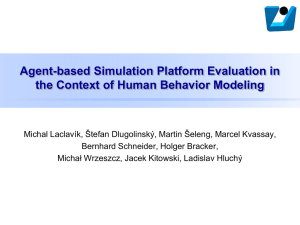Syllabus - Center for Connected Learning and Computer
advertisement
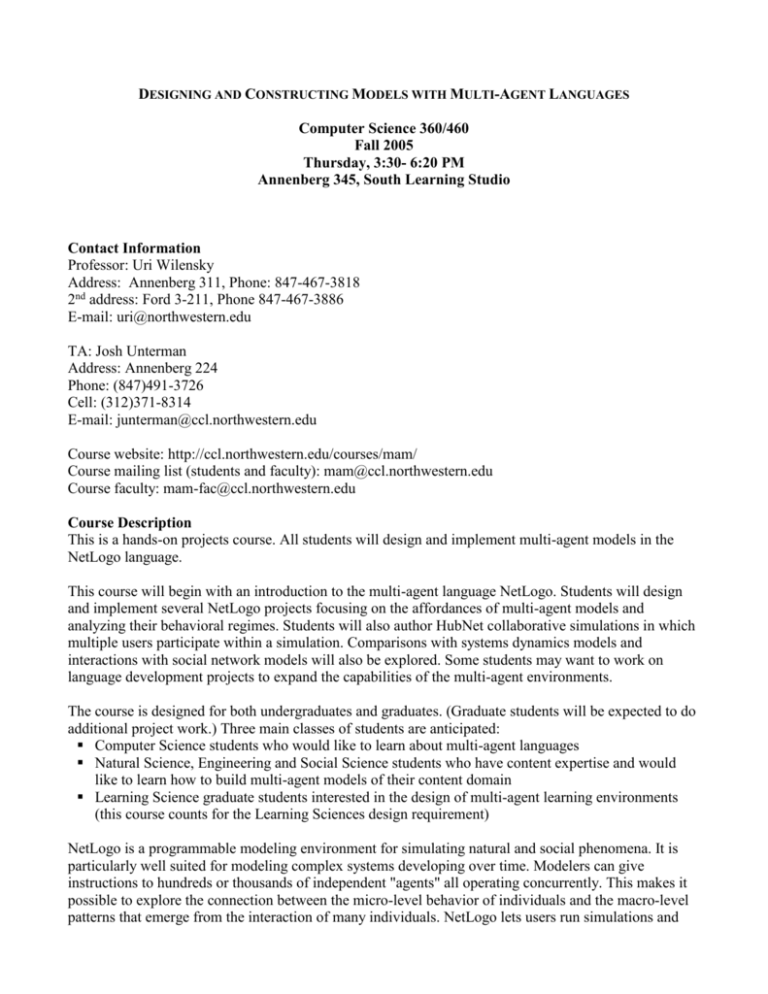
DESIGNING AND CONSTRUCTING MODELS WITH MULTI-AGENT LANGUAGES Computer Science 360/460 Fall 2005 Thursday, 3:30- 6:20 PM Annenberg 345, South Learning Studio Contact Information Professor: Uri Wilensky Address: Annenberg 311, Phone: 847-467-3818 2nd address: Ford 3-211, Phone 847-467-3886 E-mail: uri@northwestern.edu TA: Josh Unterman Address: Annenberg 224 Phone: (847)491-3726 Cell: (312)371-8314 E-mail: junterman@ccl.northwestern.edu Course website: http://ccl.northwestern.edu/courses/mam/ Course mailing list (students and faculty): mam@ccl.northwestern.edu Course faculty: mam-fac@ccl.northwestern.edu Course Description This is a hands-on projects course. All students will design and implement multi-agent models in the NetLogo language. This course will begin with an introduction to the multi-agent language NetLogo. Students will design and implement several NetLogo projects focusing on the affordances of multi-agent models and analyzing their behavioral regimes. Students will also author HubNet collaborative simulations in which multiple users participate within a simulation. Comparisons with systems dynamics models and interactions with social network models will also be explored. Some students may want to work on language development projects to expand the capabilities of the multi-agent environments. The course is designed for both undergraduates and graduates. (Graduate students will be expected to do additional project work.) Three main classes of students are anticipated: Computer Science students who would like to learn about multi-agent languages Natural Science, Engineering and Social Science students who have content expertise and would like to learn how to build multi-agent models of their content domain Learning Science graduate students interested in the design of multi-agent learning environments (this course counts for the Learning Sciences design requirement) NetLogo is a programmable modeling environment for simulating natural and social phenomena. It is particularly well suited for modeling complex systems developing over time. Modelers can give instructions to hundreds or thousands of independent "agents" all operating concurrently. This makes it possible to explore the connection between the micro-level behavior of individuals and the macro-level patterns that emerge from the interaction of many individuals. NetLogo lets users run simulations and "play" with them, exploring their behavior under various conditions. It is also an "authoring tool" which enables users (both novices and experts) to create their own models. NetLogo is simple enough that novices can easily run, explore and build their own simulations. NetLogo has extensive documentation and tutorials for all of its features. It also comes with a Models Library, which is a large collection of pre-written simulations that can be used and modified. These simulations address many content areas in the natural and social sciences, including biology and medicine, physics and chemistry, mathematics and computer science, and economics and social psychology. Several model-based inquiry curricula using NetLogo have been in use. HubNet is an extension of NetLogo that enables multiple users to collaborate and participate in a simulation. In a HubNet activity, each participant controls an agent or set of agents in a larger model. Everyone can see the world with all its agents and can control and react accordingly. Several HubNet activities are also included in the models library. The class will place significant emphasis on being a structured environment to support student projects. It is expected that class members will support each other and will make heavy use of the class mailing list (mam@ccl.northwestern.edu). Questions about NetLogo syntax, semantics and modeling idioms and efficiency should go to that list and class members are expected to read each others’ questions and reply. Requirements Read a few short papers Master NetLogo language Read, post and reply to NetLogo questions on the course mailing list Revise an existing NetLogo model from the Models Library Participate in a few HubNet collaborative simulations Revise an existing HubNet activity from the Library Do comparisons of systems dynamics models with multi-agent models Incorporate social network primitives, measures and utilities into multi-agent models Submit weekly progress reports on the final project Complete the final project: Construct at least one polished NetLogo or HubNet model and do an analysis of the model. About the Final Project The final project is to design and implement a polished NetLogo (or HubNet) model. This includes interface window, commented procedures and a full and detailed info window. The model should be embedded in a web page that describes it to a novice user. It should be possible from that web page to download the model or to run it as an applet. The final project design specification is due by October 20th. The final project is due by November 28th. Final projects will be presented on December 1st. Depending on progress, it is possible that some project presentations will take place on December 8th, so please hold that date for class. Grading All assignments and projects will be graded as either complete or incomplete. If a project is judged incomplete, you will have an opportunity to complete it or redo it the following week. You will also be assessed on your class participation both in class and virtually. If you complete two final projects, for instance, both a NetLogo model and a HubNet version of it, this will be favorably considered when determining your final grade. Graduate students must do two projects. 2 Readings Wilensky, U. (2001) Modeling Nature’s Emergent Patterns with Multi-agent Languages. Proceedings of EuroLogo 2001. Linz, Austria Wilensky, U. & Resnick, M. (1999). Thinking in Levels: A Dynamic Systems Perspective to Making Sense of the World. Journal of Science Education and Technology. Vol. 8 No. 1. pp. 3 – 18 Wilensky, U. & Stroup, W. (in review). Embodied Science Learning: Students Enacting Complex Dynamic Phenomena with the HubNet Architecture Selected further readings to be determined Schedule Please also note that class on October 13th will be rescheduled for another date. 3
